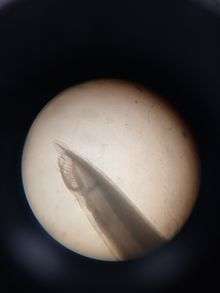Cephalochordate
| Cephalochordate Temporal range: Middle Cambrian–Recent | |
|---|---|
 | |
| A Branchiostoma lanceolatum lancelet | |
| Scientific classification | |
| Kingdom: | Animalia |
| Phylum: | Chordata |
| Subphylum: | Cephalochordata Haeckel, 1866[1] |
| Groups | |
| |
| Synonyms | |
| |
A cephalochordate (from Greek: κεφαλή kephalé, "head" and χορδή khordé, "chord") is an animal in the chordate subphylum, Cephalochordata, are characterized as chordates as they possess all 5 of the chordate characteristics during larval stages and through to adulthood. This includes: notocord, doral nerve cord, endostyle, pharynx and post-anal tail.[2] It is represented in the modern oceans by the Amphioxiformes (lancelets, also known as amphioxus). Along with its sister phylum Urochordata, Cephalochordata can be classified as belonging to the taxon Protochordata.[3]
The characteristics of Cephalochordata are that they are segmented marine animals that possess elongated bodies with a notochord that extends the length of the body extending from head to tail and it persists throughout their life.[4] The members of this subphylum are very small and have no hard parts, making their fossils difficult to find. Fossilized species have been found in very old rocks predating vertebrates. There is famous fossil shale from the Middle Cambrian Burgess Shale of British Columbia, which has yielded Pikaia fossils. Recently, a different cephalochordate fossil (Yunnanozoon) has been found in south China. It dates to the early Cambrian period and is the earliest known fossil of the cephalochordate lineage.[5] They have numerous gill slits, and have separate sexes.
Phylogeny is based on a combination of studies of extinct[6] and extant[7] species.
| |
| |||||||||||||||||||||||||||||||||||||||||||||
| |
Feeding
Cephalochordates possess an buccal cirri which assist in the movement of food into the buccal cavity, a specialized wheel organ is situated at the dorsal and posterior end of the cavity. This wheel organ is composed of epithelial cilia responsible for drawing in food, behind this organ is the velum, which acts as a filter, From here water/food is sucked back into the pharynx, excess water is pumped out through the pharyngeal slits. from here, water is passed into the atripore and then excreted from the body. [2]
References

- ↑ Nielsen, C. (July 2012). "The authorship of higher chordate taxa". Zoologica Scripta. 41 (4): 435–436. doi:10.1111/j.1463-6409.2012.00536.x.
- 1 2 Fishbeck, D. Sebastiani, A. (2015). Comparative Anatomy: manual of dissection. Morton Publisher Company.
- ↑ Hickman. Animal Diversity. Michael S. Hackett. p. 313.
- ↑ K.M. Van De Graaff and J.L. Crawley, A Photographic Atlas for the Zoology Laboratory
- ↑ Chen, J.-Y.; Dzik, J.; Edgecombe, G.D.; Ramsköld, L.; Zhou, G.-Q. (26 October 2002). "A possible Early Cambrian chordate (letters to nature)". Nature. 377: 720–722. doi:10.1038/377720a0.
- ↑ Haaramo, Mikko. Cephalochordata – lancelets. Retrieved 2013-10-22.
- ↑ Kon, T.; et al. (July 2006). "Hidden ancient diversification in the circumtropical lancelet Asymmetron lucayanum complex". Marine Biology. 149 (4): 875–883. doi:10.1007/s00227-006-0271-y.